
|   |

|   |
Prasiddha@40: A golden era redefined - Manjari Sinha e-mail: manjari@sinha.com Photos: Innee Singh March 25, 2025 Prathibha Prahlad, the founder director of 'Prasiddha Foundation' celebrated forty years of her renowned institution with a grand celebration 'Prasiddha @40: A Golden Era Redefined'. Established to further love and appreciation for all forms of art, while preserving and celebrating the enduring traditions of Indian art, the Prasiddha Foundation has been organizing festivals like the Sharad Vaibhav, Eka Aneka and Hampi Vijayotsava, as their flagship festivals annually for 25 years before it initiated the iconic Delhi International Arts Festival (DIAF) in 2007 'showcasing India's soft power and branding India as a cultural superpower internationally'. Prathibha says, "Prasiddha@40' is not just a reflection of the past but a promise to the future. It encapsulates the very essence of our four-decade journey." The 40th anniversary of the Prasiddha Foundation was celebrated with 'Ramayana Chaitravali', a three-day festival featuring specially curated performances paying tribute to India's rich artistic and storytelling traditions from the 10th to 12th of March 2025 at the Stein Auditorium of India Habitat Centre, Delhi. Conceptualized and choreographed by Prathibha Prahlad, and presented by the Prasiddha repertory, the 'Ramayana Chaitravali' opened with the first shloka uttered spontaneously by Valmiki, "Ma nishaad pratishtha... Yat kraunch mithunaad ekamavadhih kaam mohitam" as the introduction of Ramayana by the Sutradhar played by Nidhaga Karunad, who explained how Valmiki's heart melted with Karuna when he saw one of the Kraunch birds being killed by a hunter and uttering the name of Rama, Kavi Valmiki created a magnum opus epic like Ramayana. Ramayana Chaitravali took a flying start premiering 'Samarthya - the Women of Ramayana', a powerful dance-theatre production conceived by Prathibha Prahlad, that unfolded the strength, ability, resilience and willpower of the women of Ramayana. The story of Rama was retold through the kinetic energy of women like Kaikeyi, Sumitra, Shurpanakha, Mandodari and Seetha, etched through dance sequences in Odissi, Mohiniyattam, Kathakali, Kuchipudi and Bharatanatyam respectively, giving a pan-Indian feel and flavour to the poignant production. 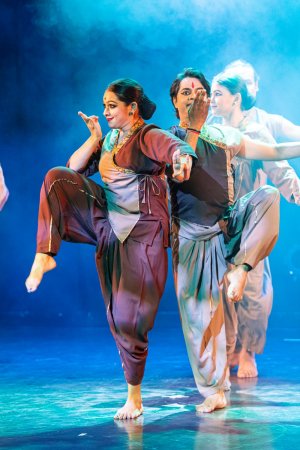 Samarthya 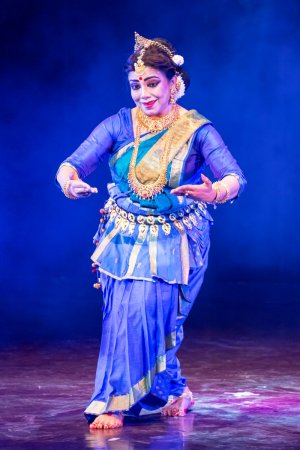 Sanchita Bhattacharya Impactful glimpses of Rama Katha were depicted through the women characters where Sanchita Bhattacharya played Kaikeyi in Odissi style, Ayswaria Wariar played Urmila in Mohiniyattam style, Haripriya Nambudiri played Shurpanakha in Kathakali style, Alekhya Punjala played Mandodari in Kuchipudi style and Prathibha lived the agony of Seetha in Bharatanatyam style. The protagonist Sage Valmiki took centre stage and set the stories of these unparalleled women in motion through monologue, poetry, music and drama. The authentic sahitya and sangeet used by the dancers of these varied dance forms brought out the strength of the women characters they played most convincingly. The two boons demanded by Kaikeyi from her husband King Dasharatha asking him to send Rama to the forest for 14 years and to make Bharata his heir, were narrated in Sanskrit from the original Valmiki Ramayana. The sacrifice of Urmila who stayed back when her husband Lakshmana accompanied Rama to the forest was even greater. Ayswaria Wariar brought out her character as if living it in person. 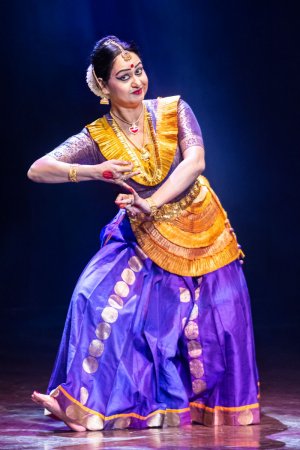 Ayswaria Wariar 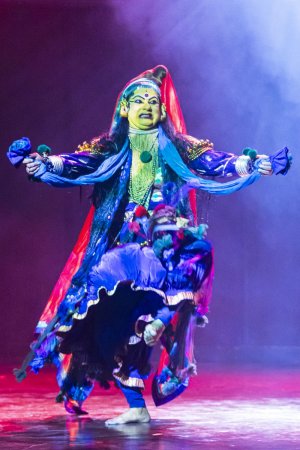 Haripriya Nambudiri The preface of the Shurpanakha episode was created with a bigger-than-life Jatayu who could recognize any voice. He predicted the appearance of Shurpanakha, whose story was effectively portrayed by Haripriya Nambudiri in Kathakali style when she appeared seductively as a maiden and then changed into her original Rakshasi form towards the end. Alekhya Punjala's abhinaya as Mandodari was most effective using the Telugu sahityam for Kuchipudi. The male voice-over enhanced the effect. Prathibha enacting the pregnant Seetha, being left behind in the forest impressed with the mercurial bhavas of Harsha and Vishaad, happiness and sadness on her face. Then the dignity of motherhood while rearing her twins, teaching them how to walk, then how to use the Astra Shastra. The rhythm progressing from slow to double and four times, to show the growing up of Lav and Kush was imaginatively composed and choreographed. The dramatic end enhanced with the sound and light design, when the self-respecting Seeta refuses to accept the glamorous status of becoming the queen of Raja Rama, the King of Ayodhya and takes refuge in her mother Bhu-Mata's lap gave goosebumps and brought tears to many eyes. 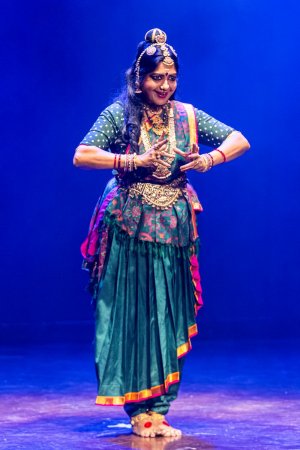 Alekhya Punjala 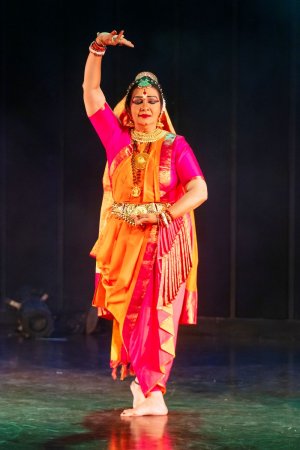 Prathibha Prahlad The depiction of each of these women characters and their unique contributions to the Ramayana became crystal clear through the impressive presentation of 'Samarthya'. How could sage Valmiki have written this widely acknowledged and revered magnum opus epic about the life story of Bhagwan Shri Rama without the kinetic energy of Mata Seeta, Kaikeyi, Shurpanakha, Urmila and Queen Mandodari? Not just the women characters of Ramayana but the whole of Prasiddha repertory did a remarkable job connecting the sequences with their group presentations. 'Setu Bandha' sequence for instance, where the army of monkeys creates an instant bridge over the sea for Rama's 'Lanka Vijay' was imaginatively choreographed by Prathibha. No wonder she got a standing ovation for this powerful production. The credits for the grand premiere of 'Samarthya - Women of Ramayana' go to Prathibha for concept and choreographic design, script - Madhavi Bhandary and Malavika Joshi, Ambient music - R. Raghunandan, Costumes - Sandhya Raman, Image - Srivatsa Shandilya, light design - Surya Rao, Voice - Ran Vijay Pratap and production support - Srinivas G. Kappanna. The dance choreography in varied styles of the female characters were done by the artistes themselves. The participating members of the Prasiddha repertory comprised the sutradhar Nidhaga Karunad, and the group of well-trained dancers like Rahul Ray, Kuleshwar Thakur, Nitin Kumar, Ram Gautam, Semai Sagolsem, Ramhari Mohanty, Arjun, Kavya Kasinathan, Rachna Karnik, Aashna Priyamvada and Prabhakar. Other highlights of the three-day festival were 'Ekam Sat', conceptualized and choreographed by Prathibha Prahlad featuring Mithun Shyam, Rekha Raju, Nidhaga Karunad, Kavya Kasinathan, Rachana Karnik, Kartik Shetty, Harshvardhan K, Raksha and Aishwarya Radhakrishnan.'Ravana - the untold story of the 11th head' presented by Surya N. Rao, 'Saumitri: The epitome of unwavering loyalty' by Praveen Kumar, and 'Vayu Putra, Bhakti redefined' by Nidhaga Karunad represented the Ramayana Chaitravali theme. 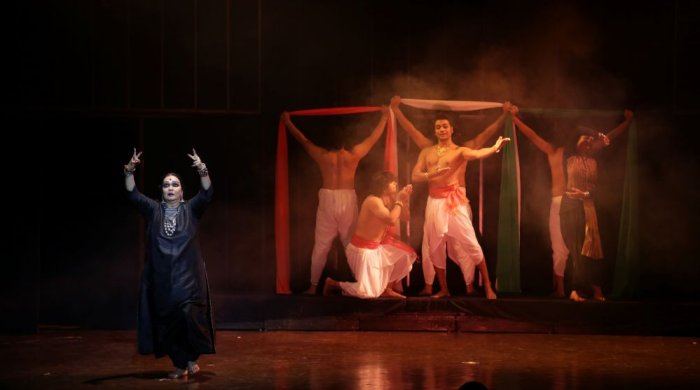 Bharat after Mahatma The concluding evening opened with 'Bharat After Mahatma' conceptualized and choreographed by Prathibha, featuring Mithun Shyam, Kuleshwar Thakur, Rahul Ray, Ram Gautam, Ramhari Mohanty, Nitin Kumar, Semai Sagolsem, Arjun, Kavya Kasinathan, and Nidhaga Karunad. The quick series of collages from the journey of Mahatma Gandhi's Champaran visit to the Viksit Bharat completing a hundred years of independence, kept the audience glued to their seats. Bhojpuri folk song "Bharat mai ke lalana... ", to the Surya Namaskar with Yogic postures performed with finesse, the Gayatri Mantra, the pathos of raga Bairagi on sarangi in the background of Gandhi's assassination, "Vaishnava jana toh," to "Prem mudit mann se kaho Rama Rama Rama", "Piba re Rama rasam", and "Raghupati Raghava Raja Ram... " to "Shuddha sundar ati manohara mantra Vande Mataram," each sequence was well conceived with appropriate lyrics, music, dramatic elements, well-choreographed sequences and the moving abhinaya of Prathibha in varied scenes that established an instant rapport with the rasikas. The 'Ramayana Chaitravali' on the concluding night featured Sathyanarayana Raju in 'Shabari - A Fable of Unwavering Faith' and Mithun Shyam portraying 'Vali - A Story of Courage and Invincibility'. The Prasiddha Foundation celebrated four decades of their artistic legacy also by honouring fellow artistes, senior dancers from various classical dance forms, critics, their co-workers from the art field including their esteemed anchor. In the usual present-day scenario of 'Me' and 'Mine', it was heartening to see Prathibha including one and all in this classy celebration of 'Prasiddha@ 40' with an open heart, maintaining the classicism intact! 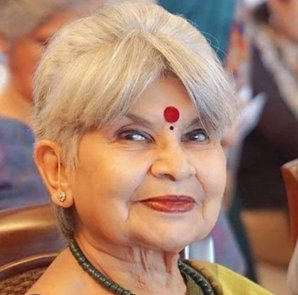 Manjari Sinha is a musicologist and an acclaimed classical music and dance critic. She has an MA in Sanskrit from Allahabad University, MA in Music from Vikram University, Ujjain; Sangeet Prabhakar in Hindustani Vocal, Tabla, Sitar and Kathak dance from Prayag Sangeet Samiti, Allahabad; and further training in Sitar under Guru Pt. Arvind Parikh in the lineage of Ustad Vilayat Khan. She has authored a book on Ustad Bade Ghulam Ali Khan, commissioned & published by Roli Books. She has contributed the chapter on Kathak for 'Indian Dance: the Ultimate Metaphor'. Her articles in English and Hindi on Music, Dance, Art & Culture are regularly showcased in a variety of leading journals and periodicals. |